Bay Area Housing Market Update - Jan '19

An investment in knowledge pays the best interest.
-Benjamin Franklin
A New Year
A new year means many things. Crowded gyms, ambitious resolutions, and esoteric predictions of what lies in store for the coming twelve months. But it also presents fresh opportunities to build, learn, and grow. At CoBuy, we are optimistic about the year ahead and excited to make homeownership more accessible and equitable for everyone.
The idea that anyone can really own land is ironic. In the best case, we are stewards of the land. Philosophy aside, we all have to live somewhere and most of us have to pay for the pleasure. Combine the opportunity to build equity in a real asset (with institutionally-supported leverage) with a place to stay, and you’ve got a compelling value proposition.
Buying a home is a big decision. Buying and owning together is complicated stuff. We started our company to help folks buy and own a home together intelligently, and that all starts with information. We believe that better information enables better decision-making. Every month, we share insights and perspectives designed to inform. We hope you find it useful, and wish you a healthy, happy 2019.
-Team CoBuy
The Big Picture
The U.S. economy has been on a roll for nearly 10 years. This stretch of stellar economic performance is unlikely to roar ahead indefinitely, but here’s a quick snapshot as we kick off 2019.
GDP
U.S. GDP is strong at 3.4%
Labor Market
Unemployment is low at 3.9% (virtual “full employment”)
Wages
Wage growth is near 10-year highs
Corporates
Corporate profits soared in 2018. Equities lost ground, but the bull run continues.
Geopolitics, global trade, fiscal policy, and monetary policy remain the wild cards in the deck - as always. But it is fair to say that on the whole, things are going pretty darn well. Last month we noted that many economists expect the pace of U.S. economic growth to temper but “remain strong”. Despite the flurry of ominous headlines over the past couple months, many big institutional investors agree. Barring a shock or force majeure, few credible market observers expect that a downturn is imminent.

National Housing Market
A crisis of housing affordability
It is clear that America has a growing problem with housing affordability. Sustained economic growth, rising wages, widespread migration towards metropolitan areas, scarce housing supply, and pre-historic housing regulation are all playing a part. Rents in many major metro areas have increased faster than wages over the past five years. Rising rents make it harder to save for the down payment necessary to purchase a home. According to Attom Data, home affordability in the U.S. has reached a 10-year low and home price appreciation is outstripping wage growth in 78% of the nation’s housing markets. Last year, the median home price rose almost 6% while the median monthly mortgage payment increased 16%.
And that’s not all. Home prices are expected to rise 5% nationally in the twelve months leading up to September 2019. The soaring cost of housing hasn’t gone unnoticed by the public: three in four Americans now believe there is a national housing affordability crisis.
There is some good news for homebuyers, however. After breaking through 5.00 percent in November, the average rate on a 30-year fixed-rate mortgage has dropped to 4.45 percent. This retracement owes largely to investor flight to quality following volatility in equity markets and lingering concerns about the government shutdown.
30-year Fixed Rate Mortgage
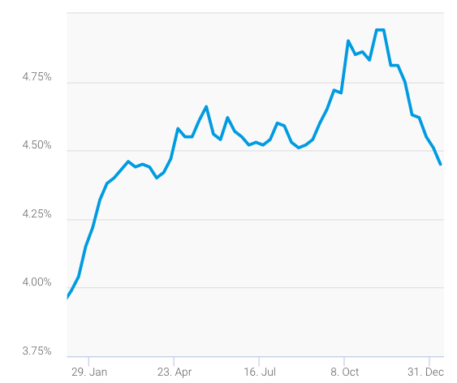
source: Freddie Mac
For a homebuyer borrowing $400k to buy a new home, a 50 basis point differential on a 30-year fixed-rate mortgage equates to $43,274 in loan repayments over the full term.
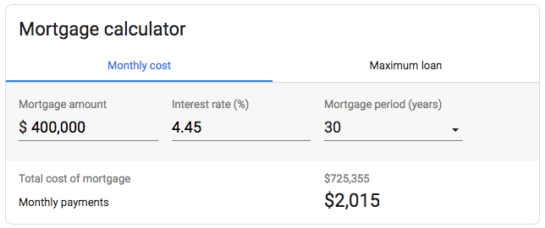
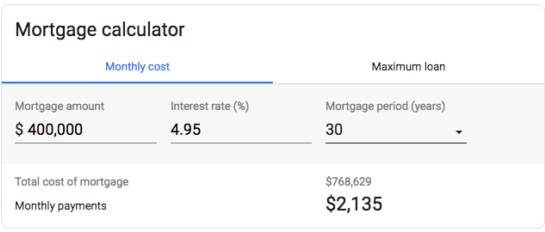
Local Housing Markets
Bay Area
The Bay Area’s local economy is one of the strongest in the nation. According to the U.S. Bureau of Labor and Statistics, the San Francisco-Oakland-Hayward metropolitan area is outperforming most metro areas with unemployment at 2.5%, annualized job growth at 1.9%, and annualized wage growth at 4.5%. This relative performance is expected to continue for the foreseeable future: economic growth is expected to rank amongst the highest in the U.S over the next 15 years.
A strong economy has fed a sustained period home price appreciation across the Bay. Median list prices peaked in May/June of last year, but have come down off the highs since then. “The median home price in the Bay Area was up 4.66% in 2018 and topped $1,000,000 for the first time. This was based on strong employment and continued strong household formations,” notes veteran mortgage banker Faramarz Moeen-Ziai. “With home prices increasing as rates went up, many buyers were forced to choose between sacrificing neighborhood, home size or budget in order to achieve their goals of homeownership. Some were able to offset this pressure by finding co-buying partners to help them get into their desired properties.”
Over the course of 2018, the median list price for a home in the SF-Oakland-Hayward metro area rose by 1% while we saw a fall of 9% in the San Jose-Sunnyvale-Santa Clara metro area.
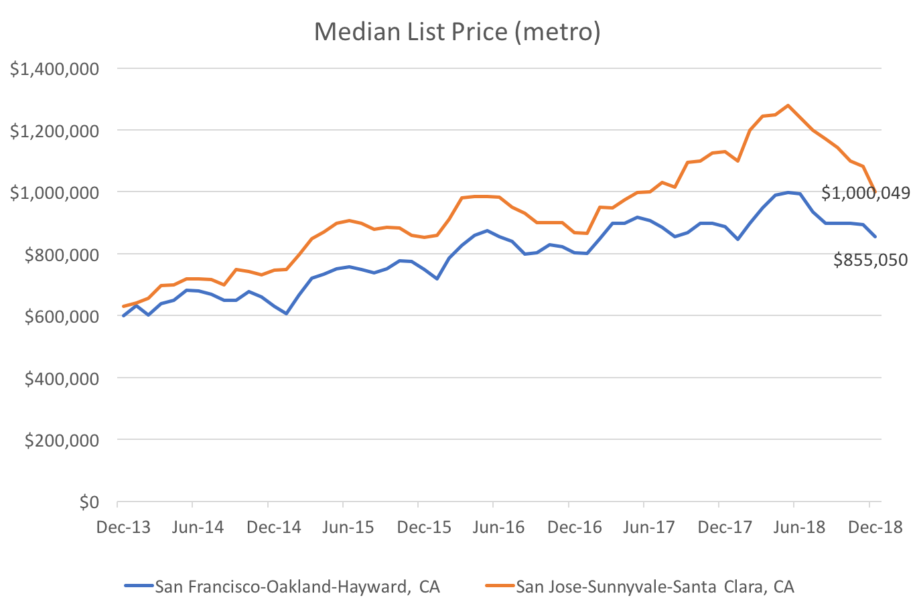
Source: data sets from realtor.com
This needs to be viewed in context. First of all, list prices, median sale prices, and home values are not the same.
List Price: the price at which a seller advertises a property for sale on the market.
Sale Price: the price at which a seller and a buyer agree to transact. The median sale price for a given data set is the price “in the middle” of all sale prices when arranged in order of value. Referencing the median sale price instead of the mean sale price is useful as it reduces skew from outlying data points.
Home Value: a proxy for the value of a property, or how much it is worth. Ultimately, the true determination of value can only be established through transacting. Most homes in a particular geography aren’t on the market, so home value indices are constructed in order to monitor fluctuations in local home values.
At the city level, we see home values are at or near their peak in San Francisco, Oakland, and a number of other cities across the Bay. According to the Case-Shiller Home Price Index, San Francisco homes appreciated nearly 8% over the last 12 months.
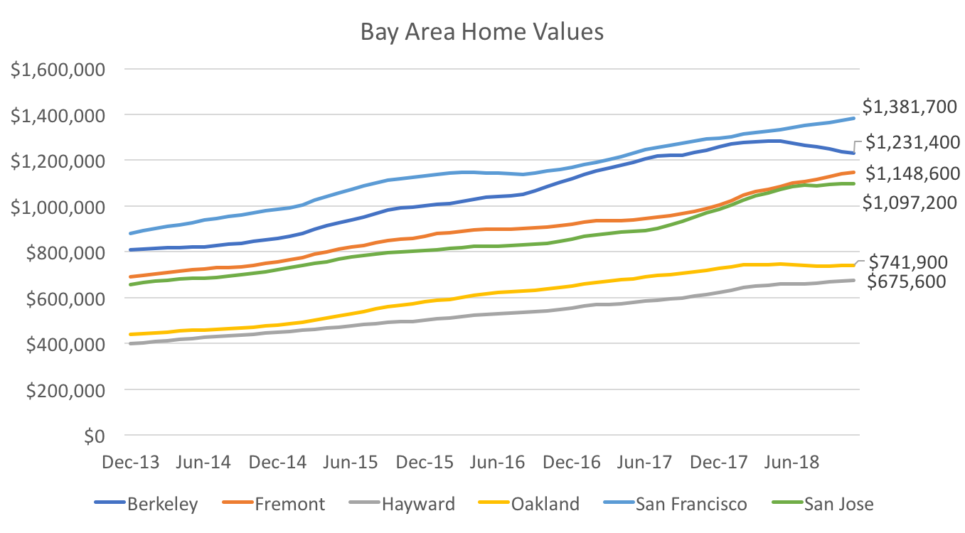
Source: data sets from Zillow Research
In essence, the second half of 2018 represents a re-balancing of sorts. The pace of home price appreciation has slowed as the frenzied buying observed in the first half of 2018 subsided. Market demand reacted to higher rates in the mortgage market, uber-competitive market dynamics, and outright price levels (NAHB reports that a $1,000 increase in home prices will see one thousand households priced out of the market in the SF-Oakland-Hayward metro area in 2019).
The supply side tells an interesting story. The number of active listings on the market normally peaks in mid to late summer. In 2018, the high point came in October. Inventory then tightened in December, dropping 30% from the highs of the year.
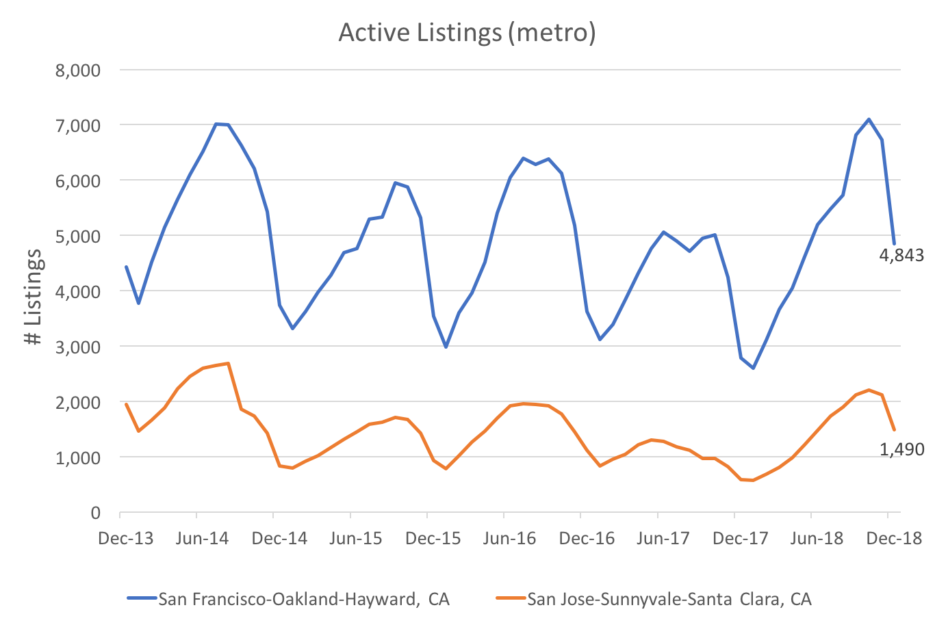
Source: data sets from realtor.com
The average days on market of a listed home in both the San Francisco and San Jose metro areas peaked in December at 51. This is consistent with traditional seasonal movements and notably lower than the national measurement for December of 80 days.
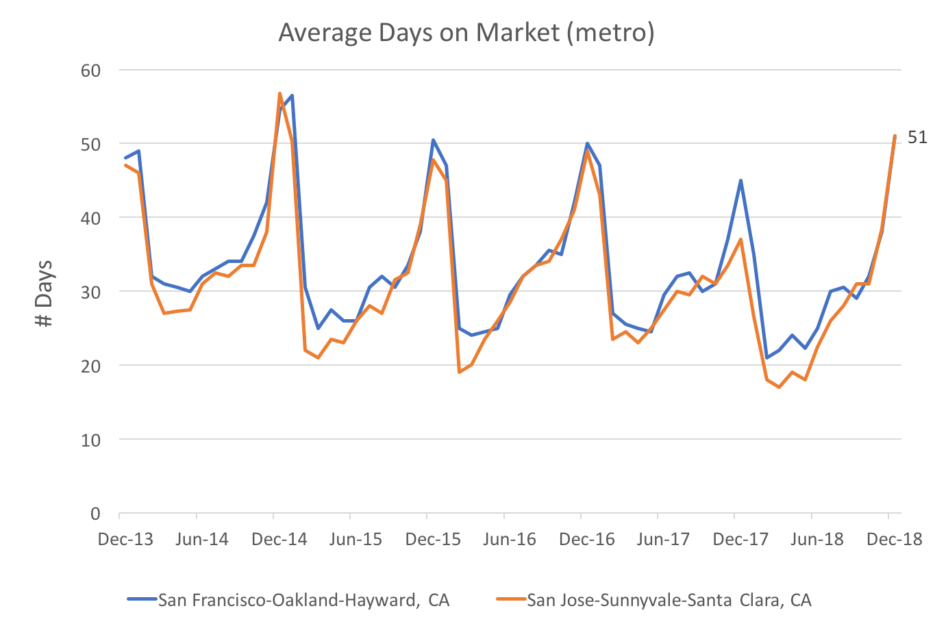
Source: data sets from realtor.com
Months supply of inventory - the time it would take for the market to digest existing supply of homes for sale - decreased in December to 1.7 months in the San Francisco-Oakland-Hayward metro area and 1.6 months in the San Jose-Sunnyvale-Santa Clara metro area. These levels indicate constrained inventory and are characteristic of a ‘sellers’ market’. For comparison, nationally the months supply of inventory for December clocked in at 3.9 months.
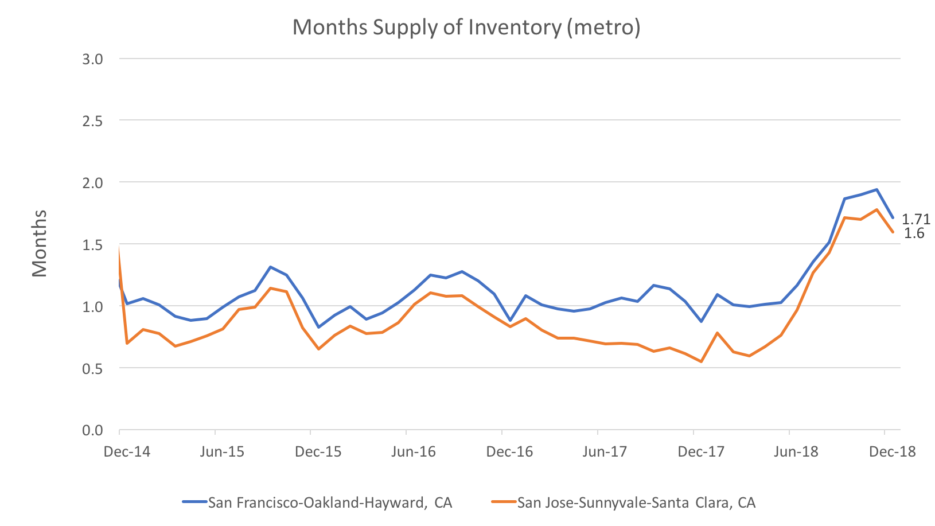
Source: data sets from realtor.com
Berkeley-based real estate agent Heather Thomson expects an improvement in the inventory situation in the first quarter. “Inventory right now is low, but expected to begin to ramp up to more or less normal levels by February/March.” Thomson sees continued appreciation across the East Bay in 2019. “Every city in the East Bay is performing a little bit differently…basically while appreciation seems to have slowed somewhat, it has not stopped, and we don’t really expect it to stop in 2019…overall, we regard the market as trending away from the white hot seller’s market of the last 4-5 years towards a more balanced market, with buyers enjoying perhaps a little more negotiating power than before.”
Spotlight 2019
What’s ahead in Q1?
In the words of Pliny the Elder, “the only certainty is that nothing is certain.” Here is what we do know…
Economic growth is expected to continue this year (and next)
The national economy is strong by historical standards, and is expected to continue to grow in 2019. The San Francisco-Oakland-Hayward metro area ranks 6th nationally for GDP, while the San Jose-Sunnyvale-Santa Clara metro has the fastest growing economy of any metro nationally with a population above one million.

The local job market is healthy and growing
Job growth is nearly 2% in the San Francisco and San Jose metros, the net employment outlook is strong, tech companies plan to add jobs in early 2019, and San Francisco consistently ranks amongst top 10 cities in the U.S. for jobs.
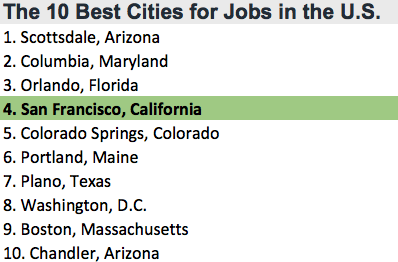
The market has shifted its view on the pace of rate hikes
Financial markets expect that the Fed will raise interest rates at a slower pace, if at all, in 2019. Fed Chairman Powell has emphasized that monetary policy should be approached with flexibility.

Rents have skyrocketed across the Bay, set to remain high
Over the past two years, the rent for a one-bedroom has increased 30% in Oakland and nearly 20% in Berkeley. San Francisco rents are expected to remain amongst the highest in the country in 2019.
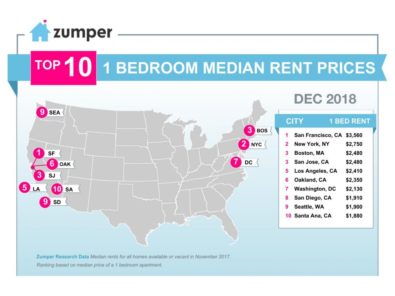
Source: Zumper Research Data, SFgate.com
Supply-side barriers persist
The time and cost required to obtain approval for new housing projects in the Bay is hindering development of (badly needed) new homes. Construction is skewed towards higher price points.
-Bay Area Council Economic Institute
IPOs in 2019 expected to feed demand for homes
“Key drivers in 2019 will be the outcome of a number of massive IPOs that are potentially occurring in 2019: Airbnb, Uber, Palantir, Lyft, Slack, Pinterest, etc.” notes Frank Sandoval, a San Francisco-based Senior Lending Officer with Bank of America. “These liquidity events could add a swarm of new buyers flush with cash to the market and ignite the fire of bidding wars that have waned during the last 6 months.”

But what’s it all mean, Basil?
The national and local economies are strong, job growth across the Bay is robust, homes are expensive, rents are expensive, supply is constrained, and the Fed looks set to approach monetary policy in a prudent manner.
There is little reason to doubt strong demand for homes around the Bay in 2019. The recent reduction in mortgage rates has already fueled an increase in mortgage applications. No doubt, those who do decide to enter the fray will be encouraged by lower borrowing costs and and more supportive market dynamics.
## Co-buying gets you more bang for your buck
*Pooling resources to buy a home can be a great way to get a down payment together and to benefit from economies of scale. Every month, we illustrate the benefits of combined purchasing power with up-to-date market data.*
In the example below, we assume:
* 10% down payment (not a hard requirement, many borrowers qualify with less)
* closing costs (buy-side) amount to 2.5% of the purchase price
* median list price for a 1-bed = $604k
* median list price for a 2-bed = $700k
* median list price for a 3-bed = $876k
* median list price for a 4-bed = $1,200k
Source: realtor.com data for SF-Oakland-Hayward Metro as of April 2019
## Economies of Scale
| Flying solo | Teaming up to co-buy |
|---|---|
| single buyer / 1 bedroom home | 3 co-buyers / 3 bedroom home |
| A single buyer would need $76k in cash up front for down payment and closing costs. | Three co-buyers would need to each contribute $37k up front for down payment and closing costs. |
Breaking it down…

On a per-bedroom basis, purchasing a three-bedroom home in the SF-Oakland-Hayward metro is currently 52% cheaper than purchasing a one-bedroom home. Economies of scale are real! Co-buying can deliver more bang for your buck and provide greater optionality.
Related Posts
Curious about co-buying?
We're here to help, seven days a week.
